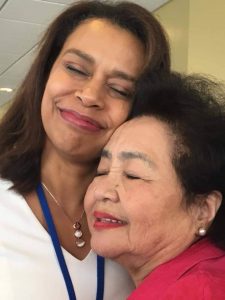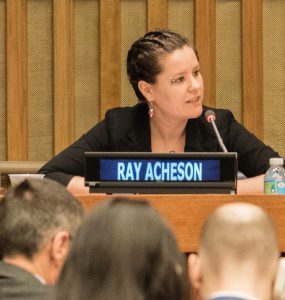
Some of the many people who worked on adopting a treaty to ban nuclear weapons: Elayne Whyte Gomez of Costa Rica and Setsuko Thurlow, a Hibakusha who was 13 years old when the atomic bomb was dropped on Hiroshima. Photo by Kathleen Sullivan.
The New Reality
by Ray Acheson, Reaching Critical Will
8 July 2017
Yesterday, we banned nuclear weapons.
It’s still hard to believe this is the case. It hasn’t fully sunk in yet, the enormity of what just happened. Even as survivors, activists, politicians, and diplomats celebrated in New York and around the world, many expressed amazement that we actually pulled it off.
It was a long campaign. Activism against nuclear weapons has been fierce and determined for over seventy years. But it wasn’t until recent years, when a few courageous diplomats in partnership with a group of civil society actors working as part of or in collaboration with the International Campaign to Abolish Nuclear Weapons decided to take a leap into the unknown, that we managed to finally develop international law condemning and prohibiting these last weapons of mass destruction.
Working together, we foregrounded our actions in resistance and hope. Resistance to the pressure from nuclear-armed and nuclear-alliance states. Resistance to attitudes of cynicism and of defeatism. Resistance to staying the course, being placated, being told to be patient, that the “important” countries will handle this matter. Hope that change is possible. Hope that by working together we can achieve something that can disrupt some of the most powerful, heavily militarised structures and doctrines in the entire world. Hope that a shared sense of humanity could prevail against all odds. Irish Foreign Minister Simon Coveney quoted Seamus Heaney in his remarks on Friday, that “hope is not optimism, which expects things to turn out well, but something rooted in the conviction that there is a good worth working for.”
There were incredible obstacles in our way. We were challenging power. In response, many forces of that power were unleashed upon us—politically, and sometimes personally. In her closing statement, Ambassador Nozipho Mxakato-Diseko of South Africa noted the “an incredible amount of pressure” on her continent not to participate. We saw this pressure placed on many countries in October before the General Assembly voted to begin these negotiations. We saw it even when states were organising conferences to examine the humanitarian impacts of nuclear weapons.
The key was not to allow these obstacles to be insurmountable. This is a choice. One can either give up or keep fighting. No obstacle is actually too big; it’s just a matter of figuring out how to go under, around, over, or through it. On Friday, 7 July, 122 governments voted yes for humanity. They took courage in their collective endeavor, and in the support of civil society filling the gallery behind them beyond capacity. They also took courage in their “moral duty,” as Ambassador Mxakato-Diseko put it, noting that “to have voted no would have been a slap in the face to the victims of Nagasaki and Hiroshima.”
Banning nuclear weapons was not an insurmountable challenge, just as achieving the elimination of nuclear weapons is not insurmountable. The day after the adoption of this treaty we are already seeing the flood of commentary on how useless what we did is. How this treaty will change nothing; how we’ve only created divisions; how we haven’t eliminated a single nuclear weapon. It will continue to be an epic mansplaining session until the trolls, who have invested their academic or political careers in reinforcing the status quo by explaining ad nauseam that this is how things are and that things can never change, get bored and move on. (Proving them wrong is apparently not sufficient—they said we could never ban nuclear weapons and now that we have, the issue its utility, not its possibility.)
It’s okay, they can have their space to complain and critique—they have always taken up this space, and until we do more to disrupt the structures that keep them safely ensconced in that space, they will continue to do so. In the meantime, the feminists, the queers, the people of colour, the survivors, the determined diplomats, the passionate politicians, the thoughtful academics, the fierce activists—the rebels and the brave—will do what we can to keep making change. We do so to honour the people who have suffered from nuclear violence. We do so to ensure that respect, dignity, courage, and love are the dominant traits of humanity, rather than our capacity for self-destruction, selfishness, or fear.
There is time for celebration but not self-congratulation. There is only time for more work. Just like the critics warned, this treaty has not magically eliminated nuclear weapons over night. We always knew it would be harder than that. But as atomic bomb survivor Setsuko Thurlow said in her remarkable closing statement to the conference on Friday, “This is the beginning of the end of nuclear weapons.” This treaty was conceived of as a tool that could help change the politics and economics of nuclear weapons as a means of facilitating disarmament. The text that we adopted on Friday is well suited to this task. It provides a solid foundation to change policies and practices, as well as to shift the thinking and discourse on nuclear weapons even further than the process to ban them already has.
We have not, as a species, been able to figure out how to solve everything at once. We struggle sometimes to even keep things on the right track, tenuous and fragile as that track can sometimes be. But we can work together to do extraordinary things—and we should do it more often. It just takes courage. It sounds over simplified, but it’s really not. We’re taught that this is a naive approach to the world—it’s engrained in us as we become adults that idealism and activism are youthful pursuits. They are not. They are the pursuits of the brave, of all ages, backgrounds, and beliefs.
This is a treaty made by people. By diplomats who got inspired by an idea and went home to change their government’s positions. By activists writing, thinking, and convening, bringing together governments and civil society groups to figure out how to make things happen. By survivors who give their testimony despite the personal trauma of reliving their experiences. By direct action crews who get arrested for breaking into nuclear weapon facilities or blockading nuclear transports or military bases. By campaigners who mobilise nationally to raise awareness and pressure their governments. By politicians who truly represent the will of their people and speak the truth in parliaments. By academics who write the theory or record the process.
This treaty is an amazing feat of collective action by people who came together to do something that had not been tried before. Like anything created by people, it has its imperfections. But it’s a good start on the road to abolition, and it gives a glimpse of what is possible in this world. That, all on its own, has meaning.
 Ray Acheson is the Director of Reaching Critical Will. She provides analysis, research, and advocacy across a range of disarmament and arms control issues.
Ray Acheson is the Director of Reaching Critical Will. She provides analysis, research, and advocacy across a range of disarmament and arms control issues.